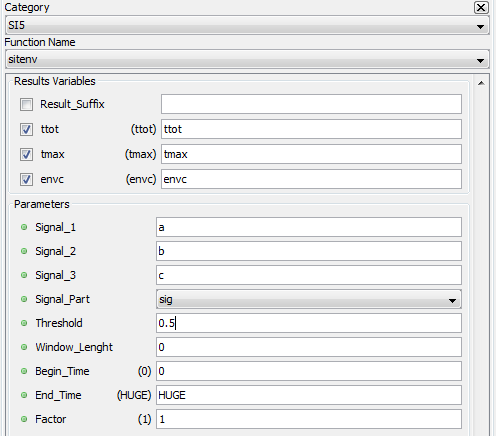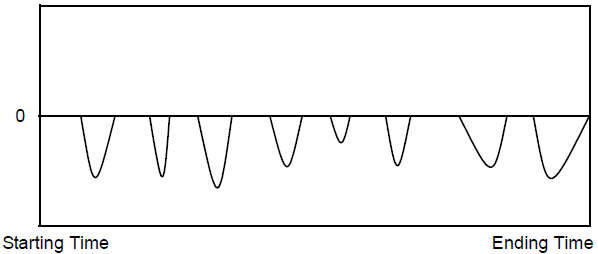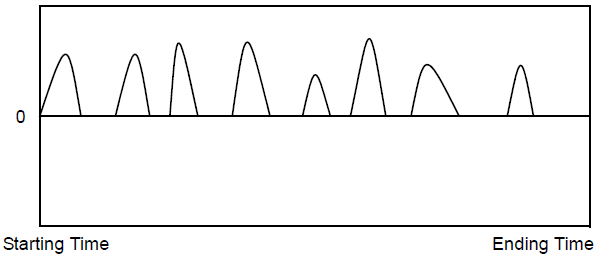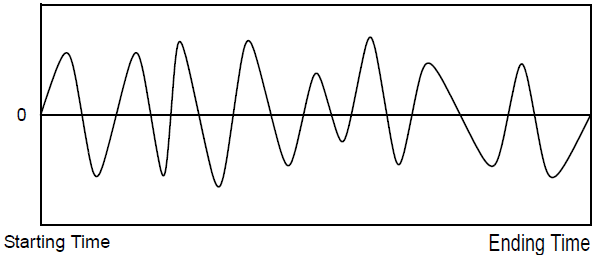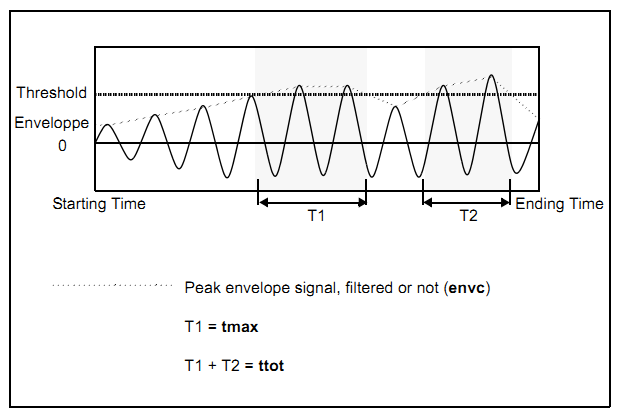Documentation Home Page ◇ HYPERSIM Home Page
Pour la documentation en FRANÇAIS, utilisez l'outil de traduction de votre navigateur Chrome, Edge ou Safari. Voir un exemple.
Advanced | SITENV
ENVELOPE OVERSHOOT– [SITENV]
Compute the time in milliseconds during which the envelope of a signal overshoots a specific threshold value.
CATEGORY
Advanced
DESCRIPTION
This function allows to compute the time in milliseconds [ms] during which the envelope of a signal overshoots a specific threshold value. This function computes the sum, the longest overshoot time and the signal representing the peak envelope.
The peak envelope is a signal consisting of lines connecting the different peaks of a signal. A peak is a sample such that the signals preceding and following it are smaller than the current sample.
RESULT VARIABLES AND PARAMETERS
| ttot | Sum of the overshoot times for the signal analyzed. This result is specified in milliseconds [ms]. |
| tmax | Longest overshoot time specified in milliseconds [ms]. |
| envc | Signal representing the peak envelope of the absolute maximum envelope for the three initial signals. |
| Signal_A | First signal to analyze |
| Signal_B | Second signal to analyze. |
| Signal_C | Third signal to analyze. |
| Signal_Part | Part of the signal on which the analysis is done (neg, pos, sig, abs). |
| Here are the definitions for the four distinct parts of a signal: | |
| Neg |
|
| Pos | Only the positive values of the input signal are used for the calculations. The other values are considered to be null. |
| Sig | The original input signal is used for the calculations. |
| Abs | The calculations are done on the absolute value of the input signal. |
| Threshold | Value of threshold to reach in order to compute the overshoot times. If the threshold is greater than the value of the first sample of the signal analyzed, then the overshoot occurs towards the top part of the signal, and vice versa. To be considered as an overshoot, the signal must reach the threshold and return under this threshold within the set limits of the analysis. Thus, if a signal is above a threshold throughout the analysis, then the ttot and tmax results will be null. |
| Window_Length | Time in seconds [s] during which the window moves over the analyzed signal. This time in seconds is reduced to the time of the analysis (end_time – begin_time), if the window time specified is longer than the duration considered for the signal. This window time cannot be null. |
| Filtering time | Period of mean setting in milliseconds used to filter the envelope signal from the peaks, if required. |
| Begin_time | Time at which the analysis of a signal must start. This time is expressed in milliseconds [ms]. This value must be greater than 0 and lower than the duration of the test. The default value is 0. |
| End_time | Time at which the analysis of a signal must end. This time is expressed in milliseconds [ms]. The value of this time must be larger than the specified begin_time and smaller than the duration of the test. Use the “HUGE” value to specify the end of the test. The default value is HUGE. The begin_time and end_time specified for the calculation of the harmonics must be the same as those used in the sifreq sequences to compute the fundamental frequency. |
| Factor: | Multiplying factor for the results generated by the function. The default value of the multiplying factor is 1.0 and has no effect on the results. The factor can only be applied to the ttot and tmax results. |
SYNTAX
[ttot, tmax, envc] = sitenv( a, b, c, "sig", 0.5, 0, 0, HUGE, 1)
CHARACTERISTICS
Data type support
Double Floating point
EXAMPLE
The following figure, shows the different function calculations for a peak envelope signal.
OPAL-RT TECHNOLOGIES, Inc. | 1751, rue Richardson, bureau 1060 | Montréal, Québec Canada H3K 1G6 | opal-rt.com | +1 514-935-2323
Follow OPAL-RT: LinkedIn | Facebook | YouTube | X/Twitter
